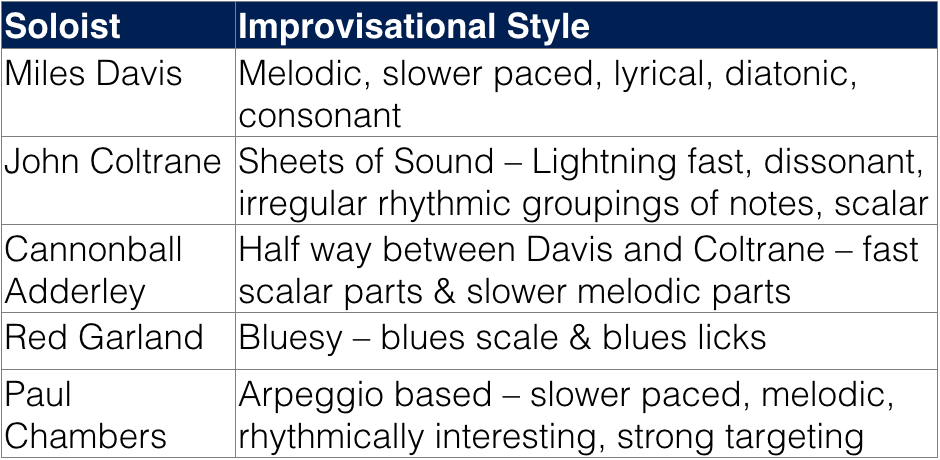The Soloists
In the below video lesson I analyse the 5 solos found in the Jazz Standard Straight, No Chaser on the Miles Davis album Milestones. The soloists are, in order of appearance:
- Cannonball Adderley (Alto Sax);
- Miles Davis (Trumpet);
- John Coltrane (Tenor Sax);
- Red Garland (Piano);
- Paul Chambers (Acoustic Bass).
Analysing these solos should give you an idea of the types of things you should look for when listening to a Jazz solo, and the types of things to include in your own improvisations. It should also help you get acquainted with the various improvisational styles of a number of Jazz Greats. The solos heard on this song are all very typical of each of the musician’s improvisational styles, at a particular point in their career. Specifically:

The Technology
To assist in analysing the solos I will be using an open source application called MuseScore (available for free download here). I’ll also make all the transcriptions freely available for download as PDFs here: Head, Miles, Cannonball, Chambers, Coltrane, Garland. And you can playback these files yourself here: click here.
Note, however, that these transcriptions are not 100% accurate, as they were partially taken from written-out scores and partially transcribed by ear. But they are accurate enough for our purposes. Also note that all instrument notation is in concert pitch so that it’s easier to read and compare.
The Notes
If you’ve read any of my other lessons you’ll know that each of the 12 notes in an octave can be categorised as either a: Chord Tone, Available Tension, or Avoid Note.
- Chord Tones are the notes of a chord (root, 3rd, 5th & 7th), so sound quite nice and consonant when played over that chord, simply because we are just repeating the chord. These will be highlighted BLUE.
- Available Tensions are notes that are not chord tones, so create a bit of dissonance, but still sound quite nice when played over a chord. These will be BLACK.
- Avoid Notes are notes that are not chord tones or available tensions, and sound really dissonant and unpleasant when played over a chord. These will be highlighted RED.
The more blue notes there are, the more consonant and pleasant the phrase – because the soloist is essentially just playing an arpeggio. The more red notes there are, the more dissonant and unpleasant the phrase – these are used to create tension. And the more black notes there are, the ‘jazzier’ the phrase – again, these create a bit of tension but still sound quite nice. And pay special attention to whether the last note of each phrase is blue or red – if it’s blue, the soloist has resolved the phrase; if it’s red, the soloist intentionally did not resolve the phrase and left it hanging; and again, if it’s black, the soloist semi-resolved it. But for this video, you don’t really need to know all the theory, in short:
- Blue notes = sound good
- Black notes = sound jazzy
- Red notes = sound bad
Indeed, when analysing the solos, we can consider red and black notes as ‘passing notes’ on our way to blue notes.
The Harmony
The difficulty in analysing solos like this is that the chords change each time you repeat the form. Straight, No Chaser is a 12 bar blues in F, but the rhythm section (piano & bass) don’t just play the standard 12 bar blues chords over and over again. They constantly change the harmony by using chord substitutions. So, if you were being a pedant or a purist, you would say that you cannot analyse the improvisation without also analysing the harmony. Now, we are not going to do that here because it’s just too complex for a YouTube video. Instead we are just going to assume that the rhythm section plays the exact same chords each time they cycle through the 12 bar blues. These chords are shown below and are a standard Jazz-Blues 12 bar progression (notice the ii-V’s).
Further, this isn’t going to be a note-by-note analysis. I didn’t want this video to be 4 hours long, it’s already long enough. Instead, we’re just going to go through each of the solos relatively quickly and I’ll just point out some interesting features or ideas that the soloists are using. If you have the time and the inclination, you can download the transcription, sit down, and work out every single scale and arpeggio being used. So this won’t be an exhaustive list of every single idea and scale that the soloist used – we will, unfortunately, skip some in the interest of time.
The Jazz Solo
While we’re doing this, look for the following techniques in particular:
- Bar-line shift
- Superimposition
- Quoting & Cliches
- Rhythmic patterns
- Melodic contour patterns
- Repetition
- Sequences
- Scale runs
- Arpeggios
- Motivic Development
- Side-slipping